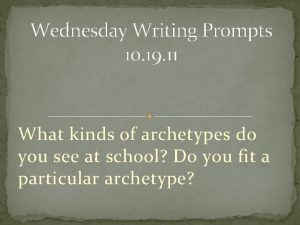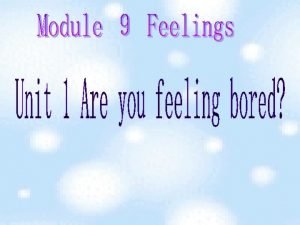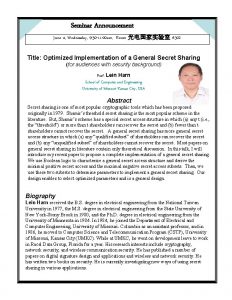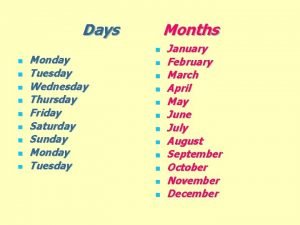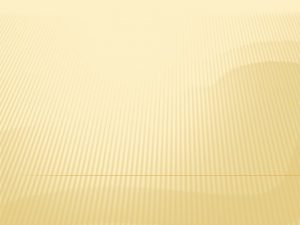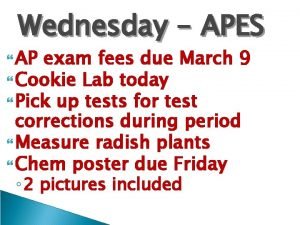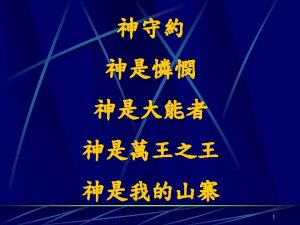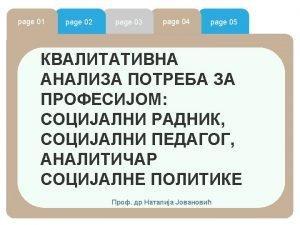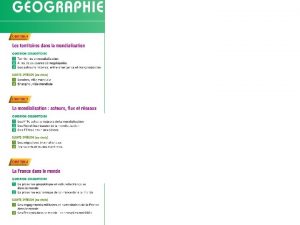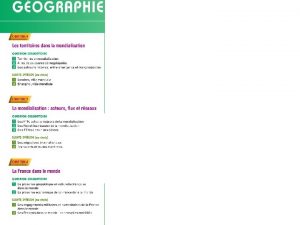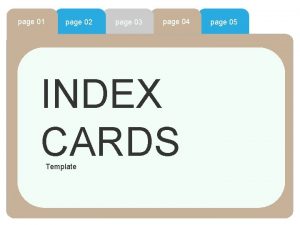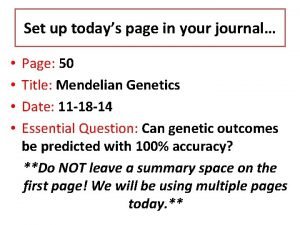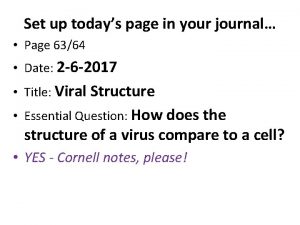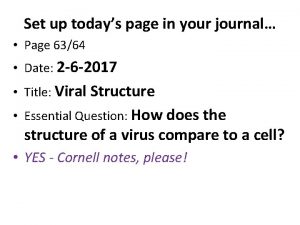HAPPY Wednesday On page 51 in your journal





































- Slides: 37

HAPPY Wednesday!!! On page 51 in your journal Answer questions 1 -7 (at your table) with your partner.

Long eyelashes (E) are dominant to short eyelashes (e). 1. 2. 3. 4. 5. 6. 7. What is the trait in this scenario? What are the two alleles in this scenario? A woman is homozygous recessive. What is her genotype? A man is homozygous dominant. What is his phenotype? A man is heterozygous for eyelashes. What is his genotype. A woman’s genotype is EE. What is her phenotype? A cross occurs between a homozygous recessive male and a heterozygous woman…. – What percent chance will their first child have long eyelashes? – What percent chance will their 8 th child have long eyelashes? • HINT…DRAW A PUNNETT SQUARE!

Long eyelashes (E) are dominant to short eyelashes (e). 1. What is the trait in this scenario? Eyelash Length

Long eyelashes (E) are dominant to short eyelashes (e). 2. What are the two alleles in this scenario? E and e OR Long and short eyelashes

Long eyelashes (E) are dominant to short eyelashes (e). 3. A woman is homozygous recessive. What is her genotype? ee

Long eyelashes (E) are dominant to short eyelashes (e). 4. A man is homozygous dominant. What is his phenotype? Long eyelashes

Long eyelashes (E) are dominant to short eyelashes (e). 5. A man is heterozygous for eyelashes. What is his genotype? Ee

Long eyelashes (E) are dominant to short eyelashes (e). 6. A woman’s genotype is EE. What is her phenotype? Long Eyelashes

Long eyelashes (E) are dominant to short eyelashes (e). 7. A cross occurs between a homozygous recessive male and a heterozygous woman…. • Male – ee • Female - Ee

Long eyelashes (E) are dominant to short eyelashes (e). 7. A cross occurs between a homozygous recessive male and a heterozygous woman…. e e E Ee Ee e ee ee

Long eyelashes (E) are dominant to short eyelashes (e). – What percent chance will their first child have long eyelashes? 50% – What percent chance will their 8 th child have long eyelashes? 50%

Test Friday

No tutorials today

You should have turned in…. Reebop Sub Day Video Notes Note Cards Harry Potter Practice Worksheet (Friday Sub Day) Penny Lab (Monday) Alien WS (Yesterday)

Set up today’s page in your journal… • Title: Dihybrid Crosses • Page: 52 • Date: 12 -2 -15 • Essential Question: How are dihybrid crosses different from a monohybrid cross?

Dihybrid Cross: a cross that shows the possible offspring for two traits Trait Two Trait one Fur Color: Color B: Black b: White Coat Texture: Texture R: Rough r: Smooth In this example, we will cross a heterozygous individual with another heterozygous individual. Their genotypes will be: Bb. Rr x Bb. Rr

Dihybrid Cross Bb. Rr x Bb. Rr DAD MOM Step 1: Find ALL possible gametes that can be made from each parent. Remember, each gamete must have one B and one R.

Foil Bb. Rr BR Br b. R br

Practice What are the possible gametes for BBrr Br Br

Practice What are the possible gametes for Hh. TT? HT HT h. T

Dihybrid Cross Bb. Rr x Bb. Rr DAD MOM Possible gametes: BR Br b. R br FOIL

Dihybrid Cross Bb. Rr x Bb. Rr DAD MOM Step 2: Arrange all possible gametes for dad on the top of your Punnett Square, and mom down the side

Dihybrid Crosses: a cross that shows the possible offspring for two traits Bb. Rr x Bb. Rr Fur Color: B: Black b: White Coat Texture: R: Rough r: Smooth Step 3: Fill in the Punnett Square (find the possible genotypes of the offspring) BR Br BR BB R R BB r R br b. B RR b. B r R Br B B R r BB r r b. B R r b. B r r b. R Bb RR Bb r R bb R R b b r. R br Bb R r Bb r r bb R r bb r r

Dihybrid Crosses BR Br b. R br BR BBRr Bb. RR Bb. Rr Br BBRr BBrr Bb. Rr Bbrr b. R Bb. Rr bb. RR bb. Rr br Bb. Rr Bbrr bb. Rr bbrr Bb. Rr x Bb. Rr Fur Color: B: Black b: White Coat Texture: R: Rough r: Smooth

How many of the offspring would have a black, rough coat? How many of the offspring would have a black, smooth coat? How many of the offspring would have a white, rough coat? How many of the offspring would have a white, smooth coat? BR Br b. R br BR BBRr Bb. RR Bb. Rr Br BBRr BBrr Bb. Rr Bbrr b. R Bb. Rr bb. RR bb. Rr br Bb. Rr Bbrr bb. Rr bbrr Fur Color: Coat Texture: B: Black R: Rough b: White r: Smooth

How many of the offspring would have black, rough coat? How many of the offspring would have a black, smooth coat? How many of the offspring would have a white, rough coat? BR Br b. R br BR BBRr Bb. RR Bb. Rr Br BBRr BBrr Bb. Rr Bbrr b. R Bb. Rr bb. RR bb. Rr br Bb. Rr Bbrr bb. Rr bbrr How many of the offspring would have a white, smooth coat? Phenotypic Ratio= 9: 3: 3: 1 Fur Color: Coat Texture: B: Black R: Rough b: White r: Smooth

Answer the following question at the bottom of your notes: What type of scientist might use a dihybrid cross?

Practice in your notes… In pea plants, yellow seeds (Y) are dominant over green seeds (y), and rounded peas (R) are dominant over wrinkled peas (r). Cross (what do you have to draw? ) a plant that is heterozygous for both traits with a plant that is homozygous recessive for both traits. Draw a Punnett square to show all possible offspring, and determine the genotypic and phenotypic ratios.

Yy. Rr X yyrr YR Yr y. R yr yr Yy. Rr Yyrr yy. Rr yyrr

More Practice • Work on the Sponge. Bob Dihybrid Cross worksheet. Turn it in at the end of class.

Fractions Method Step 1: Split the traits for mom and dad DAD MOM Bb. Rr x Bb. Rr Bb Rr

Step 2: Create 2 punnett squares. Same letters together! DAD B DAD b B BB Bb R R RR b bb r Rr MOM Bb MOM Step 3: Fill in the punnett squares r Rr rr

Step 4: Solve problems by multiplying fractions DAD B DAD b r Rr Rr rr B BB Bb R R RR b Bb bb r MOM Fur Color: B: Black b: White Coat Texture: R: Rough r: Smooth MOM How many of the offspring would have a black, smooth coat? 3 4 X 1 4 = 3 16

Step 4: Solve problems by multiplying fractions DAD B DAD b r Rr Rr rr B BB Bb R R RR b Bb bb r MOM Fur Color: B: Black b: White Coat Texture: R: Rough r: Smooth MOM How many of the offspring would have a white, rough coat? 1 4 X 3 4 = 3 16

Step 4: Solve problems by multiplying fractions DAD B DAD b r Rr Rr rr B BB Bb R R RR b Bb bb r MOM Fur Color: B: Black b: White Coat Texture: R: Rough r: Smooth MOM How many of the offspring would have a white, smooth coat? 1 4 X 1 4 = 1 16

Practice in your notes… In pea plants, yellow seeds (Y) are dominant over green seeds (y), and rounded peas (R) are dominant over wrinkled peas (r). Cross a plant that is heterozygous for both traits with a plant that is homozygous recessive for both traits. Genotypes: Yy. Rr and yyrr What is the probability that the plant will be yellow and wrinkled?

Y y Yy yy y r R Rr r rr r Rr rr How many of the offspring would have a yellow, wrinkled seed? 2 4 X 2 4 = 4 16
 You are happy i am happy
You are happy i am happy Wednesday journal prompts
Wednesday journal prompts Happy wednesday february
Happy wednesday february Happy wednesday march
Happy wednesday march Happy wednesday
Happy wednesday Response to happy monday
Response to happy monday Happy wednesday
Happy wednesday Sad happy bored
Sad happy bored Happy sad angry hungry
Happy sad angry hungry Happy sad surprised angry
Happy sad surprised angry Gecko orthotics
Gecko orthotics On each journal page, the date is written
On each journal page, the date is written Apa style headings example
Apa style headings example Monday tuesday wednesday thursday friday calendar
Monday tuesday wednesday thursday friday calendar Wednesday evening prayer
Wednesday evening prayer Wednesday seminar
Wednesday seminar Ib physics hl grade boundaries
Ib physics hl grade boundaries Web analytics wednesday
Web analytics wednesday How to write wednesday
How to write wednesday Monday my favorite day
Monday my favorite day Skinny wednesday
Skinny wednesday Pat winlink
Pat winlink Thursday tuesday
Thursday tuesday Monday tuesday wednesday thursday friday saturday sunday
Monday tuesday wednesday thursday friday saturday sunday English class is wednesday
English class is wednesday Wednesday bell work
Wednesday bell work Wednesday bellringer
Wednesday bellringer Marvelous monday terrific tuesday wonderful wednesday
Marvelous monday terrific tuesday wonderful wednesday Sunday moday
Sunday moday Wednesday bellwork
Wednesday bellwork Wednesday good morning
Wednesday good morning Wednesday morning prayer
Wednesday morning prayer Wednesday bell ringer
Wednesday bell ringer Wednesday syllables
Wednesday syllables Wednesday lunch
Wednesday lunch Thursday prayer
Thursday prayer Fe exam results wednesday
Fe exam results wednesday Wednesday phonics
Wednesday phonics

